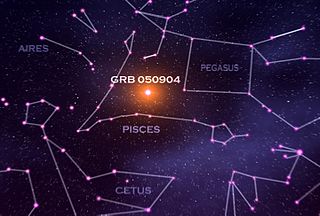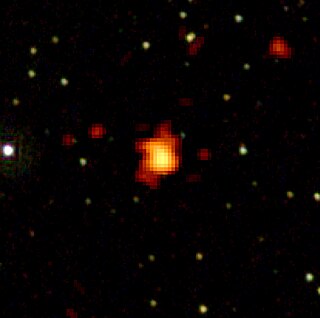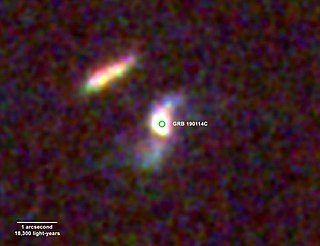
In gamma-ray astronomy, gamma-ray bursts (GRBs) are immensely energetic events occurring in distant galaxies which represent the brightest and "most powerful class of explosion in the universe." These extreme electromagnetic events are second only to the Big Bang as the most energetic and luminous phenomenon ever known. Gamma-ray bursts can last from a few milliseconds to several hours. After the initial flash of gamma rays, a longer-lived § afterglow is emitted, usually in the longer wavelengths of X-ray, ultraviolet, optical, infrared, microwave or radio frequencies.

The Fermi Gamma-ray Space Telescope, formerly called the Gamma-ray Large Area Space Telescope (GLAST), is a space observatory being used to perform gamma-ray astronomy observations from low Earth orbit. Its main instrument is the Large Area Telescope (LAT), with which astronomers mostly intend to perform an all-sky survey studying astrophysical and cosmological phenomena such as active galactic nuclei, pulsars, other high-energy sources and dark matter. Another instrument aboard Fermi, the Gamma-ray Burst Monitor, is being used to study gamma-ray bursts and solar flares.

Neil Gehrels Swift Observatory, previously called the Swift Gamma-Ray Burst Explorer, is a NASA three-telescope space observatory for studying gamma-ray bursts (GRBs) and monitoring the afterglow in X-ray, and UV/visible light at the location of a burst. It was launched on 20 November 2004, aboard a Delta II launch vehicle. Headed by principal investigator Neil Gehrels until his death in February 2017, the mission was developed in a joint partnership between Goddard Space Flight Center (GSFC) and an international consortium from the United States, United Kingdom, and Italy. The mission is operated by Pennsylvania State University as part of NASA's Medium Explorer program (MIDEX).

GRB 050904 is one of the most distant events ever observed, as of 2005. This gamma ray burst (GRB) occurred in the constellation Pisces. The bright γ-ray flash, lasting about 200 seconds, was detected on September 4, 2005 by the Swift Gamma-Ray Burst Mission. The GRB has a redshift of z=6.295. Such a high redshift means that the burst happened nearly 13 billion years ago. Therefore, the GRB exploded when the Universe was an infant, about 6% of its current age. By comparison, the most distant galaxy and the most distant quasar ever observed, as of 2005, had a redshift of 6.96 and 6.43, respectively.

Cornelis A. "Neil" Gehrels was an American astrophysicist specializing in the field of gamma-ray astronomy. He was Chief of the Astroparticle Physics Laboratory at NASA's Goddard Space Flight Center (GSFC) from 1995 until his death, and was best known for his work developing the field from early balloon instruments to today's space observatories such as the NASA Swift mission, for which he was the principal investigator. He was leading the WFIRST wide-field infrared telescope forward toward a launch in the mid-2020s. He was a member of the National Academy of Sciences and the American Academy of Arts and Sciences.

GRB 080319B was a gamma-ray burst (GRB) detected by the Swift satellite at 06:12 UTC on March 19, 2008. The burst set a new record for the farthest object that was observable with the naked eye: it had a peak visual apparent magnitude of 5.7 and remained visible to human eyes for approximately 30 seconds. The magnitude was brighter than 9.0 for approximately 60 seconds. If viewed from 1 AU away, it would have had a peak apparent magnitude of −67.57. It had an absolute magnitude of −38.6, beaten by GRB 220101A with −39.4 in 2023.

GRB 080916C is a gamma-ray burst (GRB) that was recorded on September 16, 2008, in the Carina constellation and detected by NASA's Fermi Gamma-ray Space Telescope. The burst lasted for 23 minutes. It is one of the most extreme gamma-ray bursts ever recorded, and was the most energetic gamma-ray burst ever recorded, until GRB 221009A was recorded in 2022. The explosion had the energy of approximately 9000 type Ia supernovae if the emission was isotropically emitted, and the gas jets emitting the initial gamma rays moved at a minimum velocity of approximately 299,792,158 m/s, making this blast one of the most extreme recorded.

The Gamma-Ray Burst Optical/Near-Infrared Detector (GROND) is an imaging instrument used to investigate Gamma-Ray Burst afterglows and for doing follow-up observations on exoplanets using transit photometry. It is operated at the 2.2-metre MPG/ESO telescope at ESO's La Silla Observatory in the southern part of the Atacama desert, about 600 kilometres north of Santiago de Chile and at an altitude of 2,400 metres.
The history of gamma-ray began with the serendipitous detection of a gamma-ray burst (GRB) on July 2, 1967, by the U.S. Vela satellites. After these satellites detected fifteen other GRBs, Ray Klebesadel of the Los Alamos National Laboratory published the first paper on the subject, Observations of Gamma-Ray Bursts of Cosmic Origin. As more and more research was done on these mysterious events, hundreds of models were developed in an attempt to explain their origins.

GRB 090423 was a gamma-ray burst (GRB) detected by the Swift Gamma-Ray Burst Mission on April 23, 2009, at 07:55:19 UTC whose afterglow was detected in the infrared and enabled astronomers to determine that its redshift is z = 8.2, making it one of the most distant objects detected at that time with a spectroscopic redshift.

Gamma-ray astronomy is a subfield of astronomy where scientists observe and study celestial objects and phenomena in outer space which emit cosmic electromagnetic radiation in the form of gamma rays, i.e. photons with the highest energies at the very shortest wavelengths. Radiation below 100 keV is classified as X-rays and is the subject of X-ray astronomy.

GRB 991216, nicknamed the Beethoven Burst by Dr. Brad Schaefer of Yale University, was a gamma-ray burst observed on December 16, 1999, coinciding with the 229th anniversary of Ludwig van Beethoven's birth. A gamma-ray burst is a highly luminous flash associated with an explosion in a distant galaxy and producing gamma rays, the most energetic form of electromagnetic radiation, and often followed by a longer-lived "afterglow" emitted at longer wavelengths.

GRB 090429B was a gamma-ray burst observed on 29 April 2009 by the Burst Alert Telescope aboard the Swift satellite. The burst triggered a standard burst-response observation sequence, which started 106 seconds after the burst. The X-ray telescope aboard the satellite identified an uncatalogued fading source. No optical or UV counterpart was seen in the UV–optical telescope. Around 2.5 hours after the burst trigger, a series of observations was carried out by the Gemini North telescope, which detected a bright object in the infrared part of the spectrum. No evidence of a host galaxy was found either by Gemini North or by the Hubble Space Telescope. Though this burst was detected in 2009, it was not until May 2011 that its distance estimate of 13.14 billion light-years was announced. With 90% likelihood, the burst had a photometric redshift greater than z = 9.06, which would make it the most distant GRB known, although the error bar on this estimate is large, providing a lower limit of z > 7.

GRB 101225A, also known as the "Christmas burst", was a cosmic explosion first detected by NASA's Swift observatory on Christmas Day 2010. The gamma-ray emission lasted at least 28 minutes, which is unusually long. Follow-up observations of the burst's afterglow by the Hubble Space Telescope and ground-based observatories were unable to determine the object's distance using spectroscopic methods.

GRB 130427A was a record-setting gamma-ray burst, discovered starting on April 27, 2013. This GRB was associated to SN 2013cq, of which the appearance of optical signal was predicted on May 2, 2013 and detected on May 13, 2013. The Fermi space observatory detected a gamma-ray with an energy of at least 94 billion electron volts. It was simultaneously detected by the Burst Alert Telescope aboard the Swift telescope and was the brightest burst Swift had ever detected. It was the closest 5% of GRBs, at about 3.6 billion light-years away, and was comparatively long-lasting.
Fermi's Large Area Telescope (LAT) recorded one gamma ray with an energy of at least 94 billion electron volts (GeV), or some 35 billion times the energy of visible light, and about three times greater than the LAT's previous record. The GeV emission from the burst lasted for hours, and it remained detectable by the LAT for the better part of a day, setting a new record for the longest gamma-ray emission from a GRB.

GRB 160625B was a bright gamma-ray burst (GRB) detected by NASA's Fermi Gamma-ray Space Telescope on 25 June 2016 and, three minutes later, by the Large Area Telescope. This was followed by a bright prompt optical flash, during which variable linear polarization was measured. This was the first time that these observations were made when the GRB was still bright and active. The source of the GRB was a possible black hole, within the Delphinus constellation, about 9 billion light-years (light travel distance) away (a redshift of z = 1.406). It had a fluence of 5.7×10−4 erg cm−2, and energy of 5 × 1054 erg. The burst lasted over 11 minutes (680 s), and is one of the most energetic bursts ever recorded.

GRB 190114C was an extreme gamma-ray burst explosion from a galaxy 4.5 billion light years away (z=0.4245; magnitude=15.60est) near the Fornax constellation, that was initially detected in January 2019. The afterglow light emitted soon after the burst was found to be tera-electron volt radiation from inverse Compton emission, identified for the first time. According to the astronomers, "We observed a huge range of frequencies in the electromagnetic radiation afterglow of GRB 190114C. It is the most extensive to date for a gamma-ray burst." Also, according to other astronomers, "light detected from the object had the highest energy ever observed for a GRB: 1 Tera electron volt (TeV)—about one trillion times as much energy per photon as visible light"; another source stated, "the brightest light ever seen from Earth [to date]."

GRB 221009A was an extraordinarily bright and very energetic gamma-ray burst (GRB) jointly discovered by the Neil Gehrels Swift Observatory and the Fermi Gamma-ray Space Telescope on October 9, 2022. The gamma-ray burst was ten minutes long, but was detectable for more than ten hours following initial detection. Despite being around 2.4 billion light-years away, it was powerful enough to affect Earth's atmosphere, having the strongest effect ever recorded by a gamma-ray burst on the planet. The peak luminosity of GRB 221009A was measured by Konus-Wind to be ~ 2.1 × 1047 W and by Fermi Gamma-ray Burst Monitor to be ~ 1.0 × 1047 W over its 1.024s interval. A burst as energetic and as close to Earth as 221009A is thought to be a once-in-10,000-year event. It was the brightest and most energetic gamma-ray burst ever recorded, with some dubbing it the BOAT, or Brightest Of All Time.

GRB 230307A was an extremely bright, long duration gamma-ray burst (GRB), likely produced as a consequence of a neutron star merger or black hole - neutron star merger event. It lasted around three minutes, and was observed to have a gamma ray fluence of 3×10−4 erg cm−2 in the 10 to 1000 KeV (electronvolt) range making it second only to GRB 221009A, which was an extremely bright and long duration gamma ray burst deemed to be the Brightest Of All Time. The burst was around 1000 times more powerful than a typical gamma-ray burst. The burst had the second-highest gamma-ray fluence ever recorded. The James Webb Space Telescope (JWST) detected the chemical signature for tellurium (Te). The neutron stars were once part of a spiral galaxy but were kicked out via gravitational interactions. Then while outside of the main galaxy at a distance of 120,000 light years, they merged, creating GRB 230307A.

















